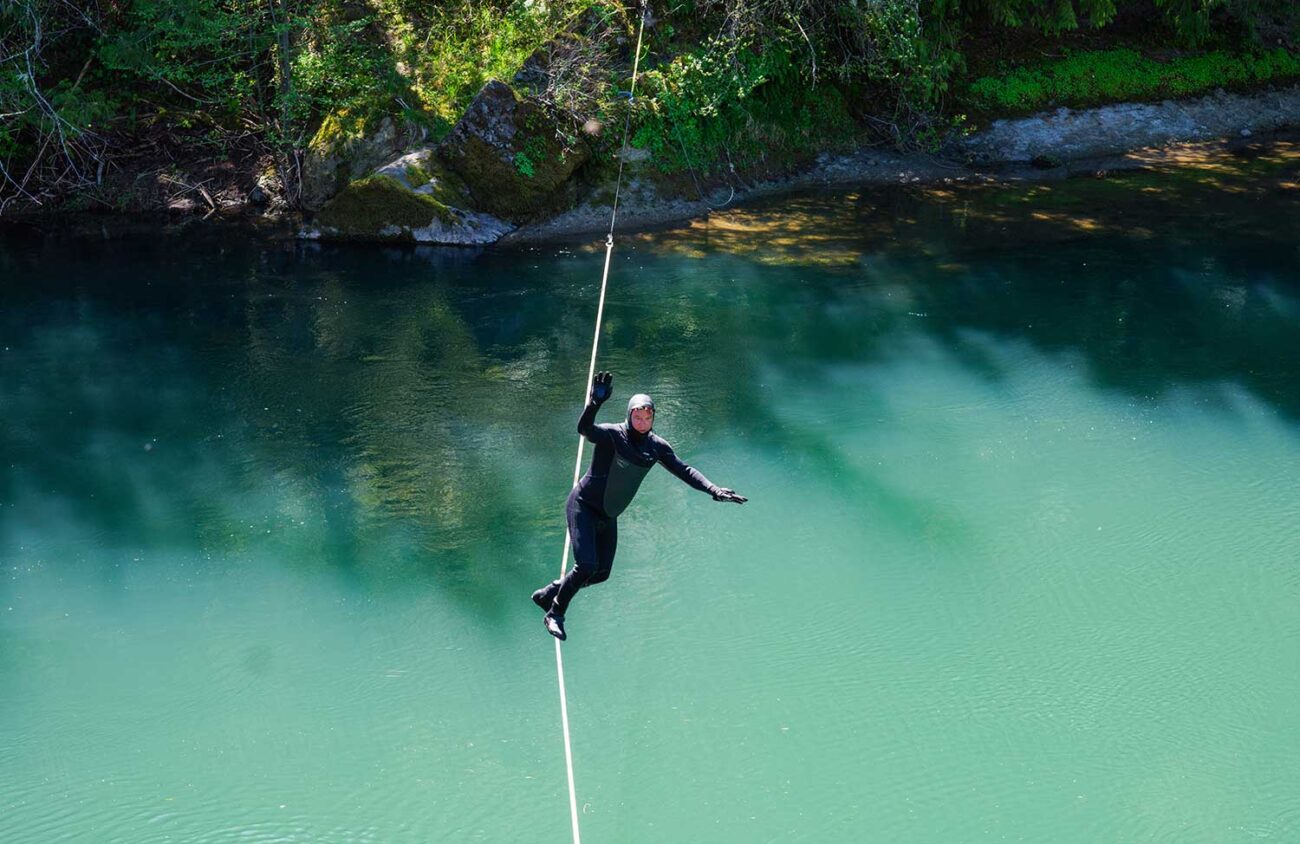Adam Grosowsky surfs back and forth just feet above the rushing water of the Row River. At 65 years old, he’s just as agile on the 110-foot slackline as he was when he first created the popular solo sport in his 20s.
Grosowsky grew up climbing the sandstone cliffs of Carbondale, Illinois. Right before he left for Evergreen State College in Olympia, Washington, Grosowsky says he free-soloed the then-hardest climb in Carbondale. The route had a climbing grade of 5.12, or “advanced,” which Grosowsky says “right now is nothing, but back in the day was this amazing, unattainable thing that nobody had done.”
Grosowsky and his friends were incredibly confident in their climbing prowess, he says, so they hitchhiked to Yosemite National Park during their first Thanksgiving break from college to “show the world how it’s done.”
“We just got our asses fucking fully kicked,” Grosowsky says. “I mean, smoked.”
Defeated and cold in the snow, Grosowsky went looking for a ride back to Evergreen when he came across Camp 4, a campground that’s well-regarded as a resting place for avid rock climbers.
“I saw this movement, this incredibly calm movement through the trees,” Grosowsky says. “And I was like, ‘The fuck is that?’”
“That” was Ron Kauk, a longtime resident of Camp 4 and Yosemite-climbing legend, walking the dangling length of a slack-chain, a length of metal chain hung loosely between two points. Grosowsky says he’d heard of tight rope walking before, but he’d not seen someone walk a slack surface before.
Grosowsky was determined to recreate Kauk’s impressive acts of balance, he says, so he purchased a quarter-inch diameter rope from a hardware store and hung it up between two trees on his college campus. The first time he stepped on the rope, Grosowsky says, he “ate total shit.”
“I had the pattern of the concrete ridges in my face. It’s just like, fuck, that really hurt,” Grosowsky says. “And the next day, I was like, ‘Why don’t we use climbing webbing?’”
Unlike the cylindrical rope that rolls under the pressure of feet, climbing webbing provides a flat and flexible surface that’s ideal to balance on.
“The webbing has this amazing tensile quality to it instead of just being a dead, static thing,” Grosowsky says. “It flexes like a rubber band.”
Following their switch from rope to webbing, Grosowsky and his close friend Jeff Ellington were credited by The New York Times with the invention of the now widespread solo sport.
Grosowsky went on to earn two master’s degrees — one in arts and one in the fine arts of printmaking — from the University of Iowa, and when he graduated with his second in 1986, he picked up and drove to Eugene — the “mecca of the rock climbing scene,” he says — with $400 in his pocket. That was around the same time that Smith Rock in Deschutes County took off as the hot new spot for climbing.
The first time he visited Smith Rock, Grosowsky says, he had an epiphany at Monkey Face.
“That’s the place to put a wire,” Grosowsky says. “If there’s a place anywhere in the world that is a perfect, naturally set up place to put a wire up.”
Although it was a tight wire, a length of wire rather than the climbing webbing of a slackline, that Grosowsky attached to the 350-foot spire, the principles of balance and focus remained. Grosowsky crossed the wire a few times on belay — a rope attaching him to the wire — before walking it once without. A photographer saw him free walking the line and snapped a picture that was later used in a U.S. Bank ad about having “the guts.”
Since then, Grosowsky has continuously added to his skillset: Handstands, juggling, surfing and knife throwing have all joined his slackline repertoire. Most of his current tricks are done over water, Grosowsky says, because while “water can be very, very unforgiving, it’s better than falling on the ground.”
The beauty of slacklining as a hobby, though, is that it doesn’t have to be an extreme sport. Instead, it can be a meditative session in the park.
“It’s incredibly good for my psyche,” Grosowsky says. “It’s just so calming and centering.”
It’s no surprise then that slacklining’s popularity expanded out of the climbing sphere and into the average Joe’s peaceful afternoon. Just be careful of “the falling down thing,” Grosowsky says, and take it one step at a time.
“I can’t even drive around town; you go anywhere and there’s some kid on a slack wire,” Grosowsky says. “It’s very gratifying that a bunch of knuckleheads are having a blast.”
